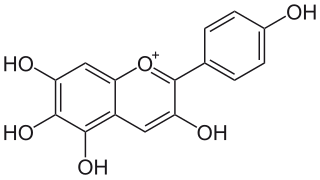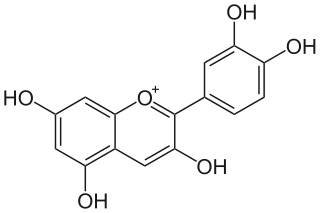This page is based on this
Wikipedia article Text is available under the
CC BY-SA 4.0 license; additional terms may apply.
Images, videos and audio are available under their respective licenses.

Anthocyanidins are common plant pigments. They are the sugar-free counterparts of anthocyanins based on the flavylium ion or 2-phenylchromenylium, which is a type of oxonium ion. They form a large group of polymethine dye. In particular anthocyanidins are salt derivatives of the 2-phenylchromenylium cation, also known as flavylium cation. As shown in the figure below, the phenyl group at the 2-position can carry different substituents. The counterion of the flavylium cation is mostly chloride. With this positive charge, the anthocyanidins differ from other flavonoids.
31 monomeric anthocyanidins have been properly identified, most of the anthocyanins are based on cyanidin (30%), delphinidin (22%), and pelargonidin (18%), respectively. Altogether 20% of the anthocyanins are based on the three common anthocyanidins that are methylated. Around 3, 3, and 2% of the anthocyanins or anthocyanidins are labeled as 3-desoxyanthocyanidins, rare methylatedanthocyanidins, and 6-hydroxyanthocyanidins, respectively.

Delphinidin is an anthocyanidin, a primary plant pigment, and also an antioxidant. Delphinidin gives blue hues to flowers in the genera Viola and Delphinium. It also gives the blue-red color of the grape that produces Cabernet Sauvignon, and can be found in cranberries and Concord grapes as well as pomegranates, and bilberries.

Peonidin is an O-methylated anthocyanidin derived from Cyanidin, and a primary plant pigment. Peonidin gives purplish-red hues to flowers such as the peony, from which it takes its name, and roses. It is also present in some blue flowers, such as the morning glory.
In enzymology, a flavonol synthase is an enzyme that catalyzes the following chemical reaction :
In enzymology, a leucocyanidin oxygenase (EC 1.14.11.19) is an enzyme that catalyzes the chemical reaction
In enzymology, an anthocyanin 5-aromatic acyltransferase is an enzyme that catalyzes the chemical reaction
In enzymology, an anthocyanin 6"-O-malonyltransferase is an enzyme that catalyzes the chemical reaction
In enzymology, an anthocyanidin 3-O-glucosyltransferase is an enzyme that catalyzes the chemical reaction

Anthocyanins are water-soluble vacuolar pigments that, depending on their pH, may appear red, purple, or blue. Food plants rich in anthocyanins include the blueberry, raspberry, black rice, and black soybean, among many others that are red, blue, purple, or black. Some of the colors of autumn leaves are derived from anthocyanins.

Rosinidin is an O-methylated anthocyanidin derived from Cyanidin. It is a pigment found in the flowers of Catharanthus roseus and, in lower concentration, in Primula rosea.
The molecular formula C16H13O7 (or C16H13O7+, molar mass : 317.27 g/mol, exact mass : 317.066127317) or C16H13ClO7 (exact mass : 352.03498) may refer to :
The molecular formula C15H11O5 (or C15H11O5+, molar mass : 271.24 g/mol, exact mass 271.060648) may refer to :
The chemical formula C17H15O7 (or C17H15O7+, molar mass : 331.2968 g/mol, exact mass :331.081778) may refer to :
The molecular formula C15H11O7 (molar mass : 303.24 g/mol, exact mass : 303.050477) may refer to:
The chemical compound C15H11O4 (or C15H11O4+, molar mass : 255.24 g/mol, exact mass : 255.065734) may refer to :
The molecular formula C18H17O7 (or C18H17O7+, molar mass : 345.32 g/mol, exact mass : 345.097428) may refer to :

Hirsutidin is an O-methylated anthocyanidin, a chemical compound belonging to the anthocyanins. It can be found in Catharanthus roseus where it is the prominent compound in petals and can also be found in callus cultures.

Leucocyanidin is a colorless chemical compound that is a member of the class of natural products known as leucoanthocyanidins.

Pulchellidin (Pl) is an O-methylated anthocyanidin. It is a blue-red plant pigment. It can be found in Plumbago pulchella.

p-Coumaroylated anthocyanins are a type of anthocyanins with a p-coumaric acid unit linked with a sugar to an anthocyanidin aglycone. 3-(6-p-Coumaroyl)glucosides are found in grape and wine. Cyanidin-3-O-(di-p-coumarylglucoside)-5-glucoside is found in dark opal basil. Red leaves of Perilla frutescens also accumulate cyanidin 3-(6-O-p-coumaroyl-β- D-glucoside)-5-(6-O-malonyl-β-D-glucoside).











